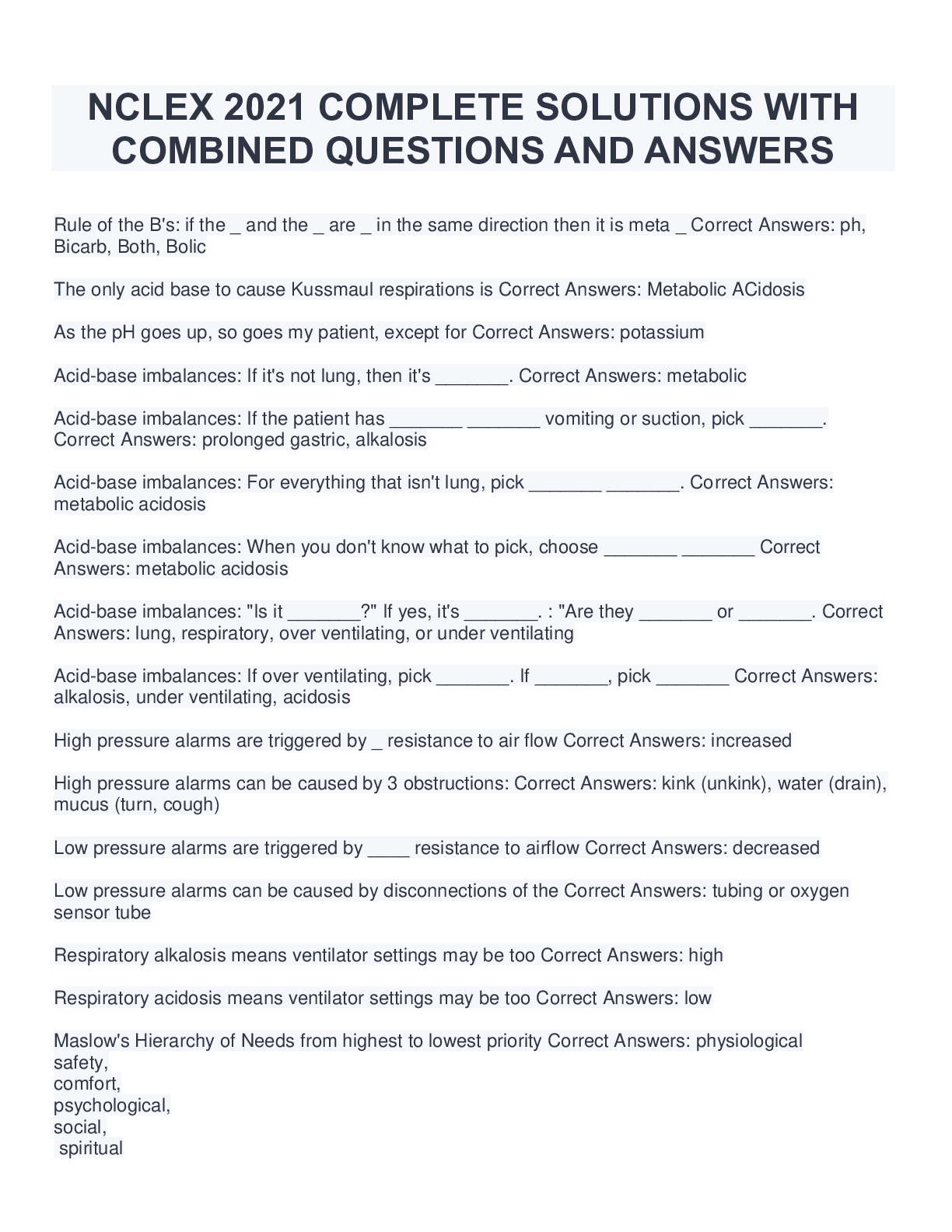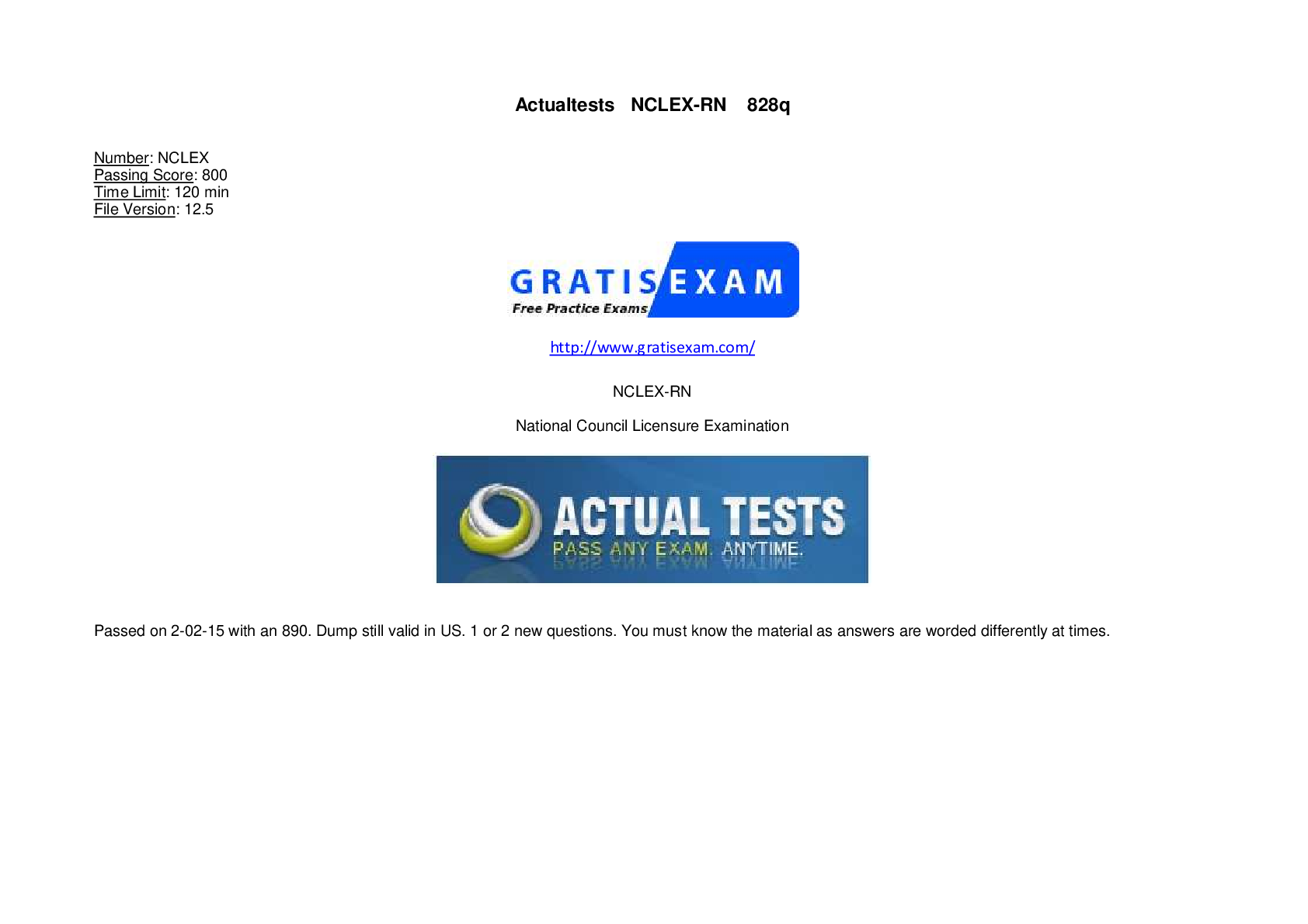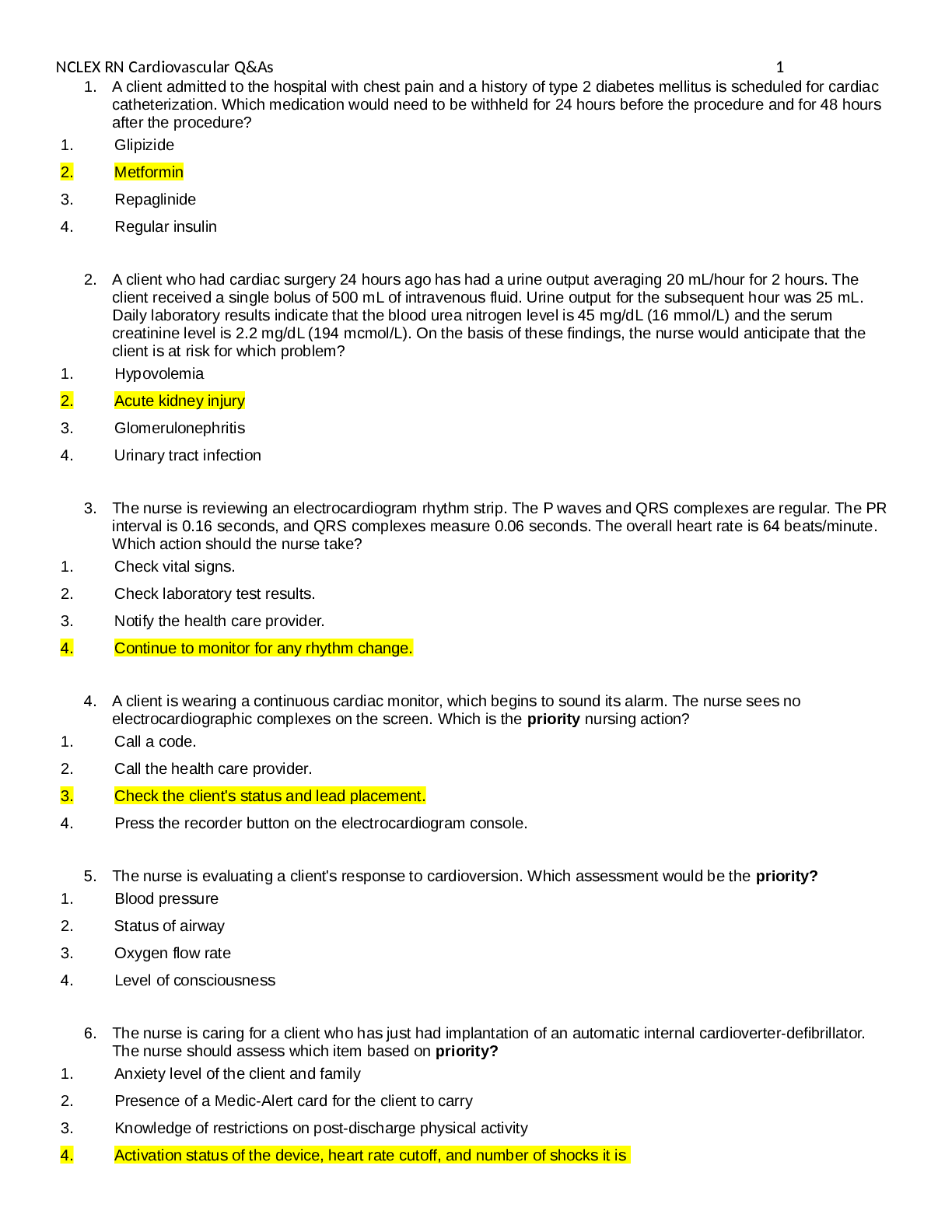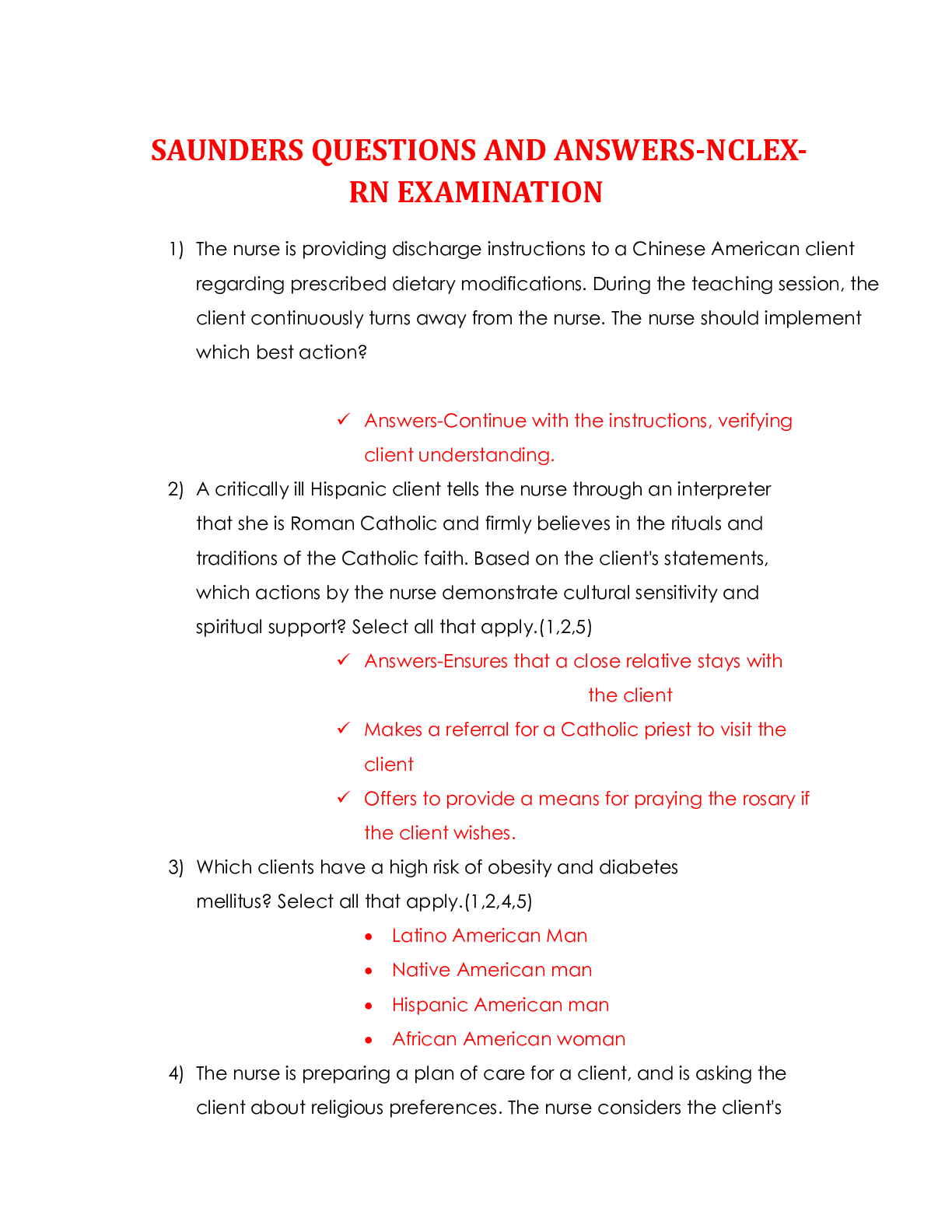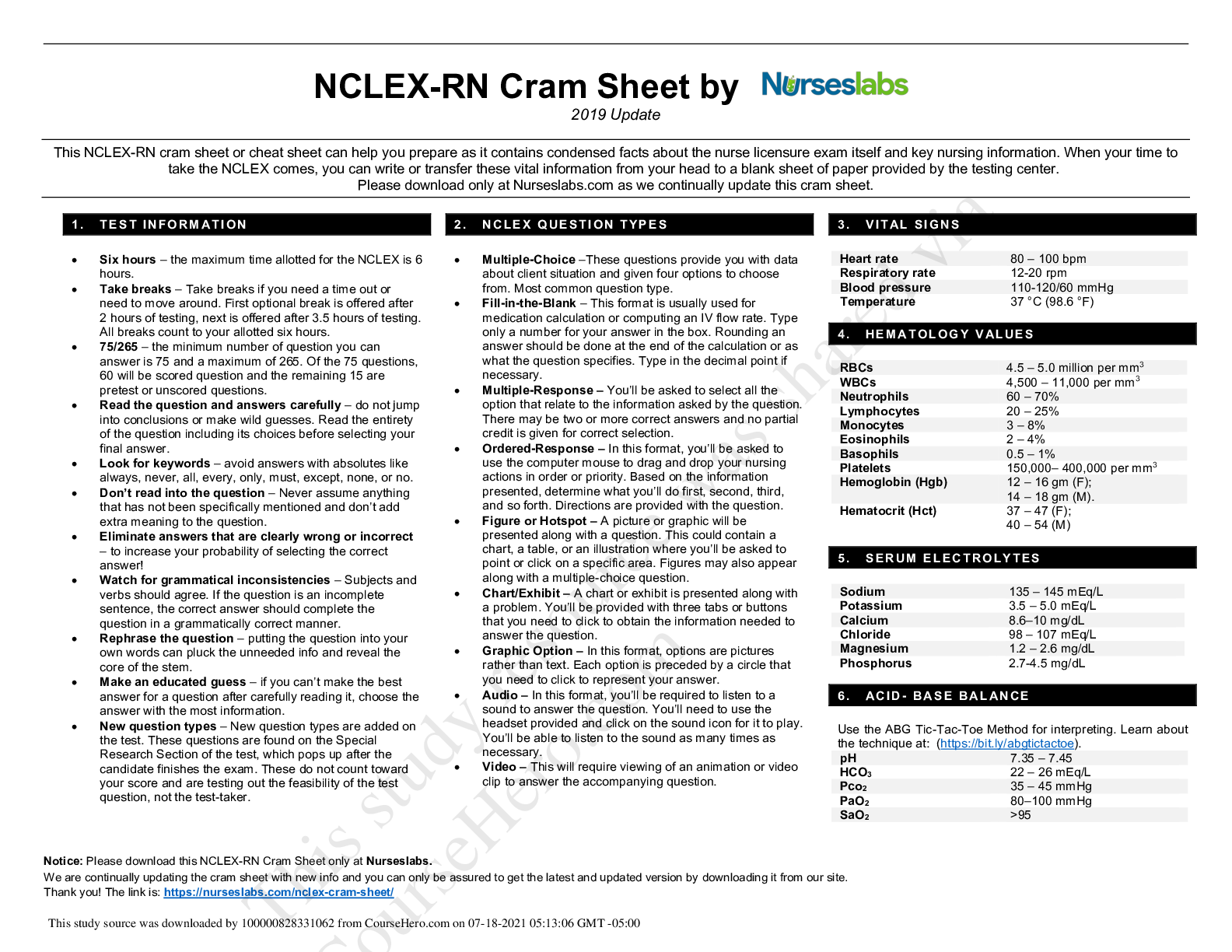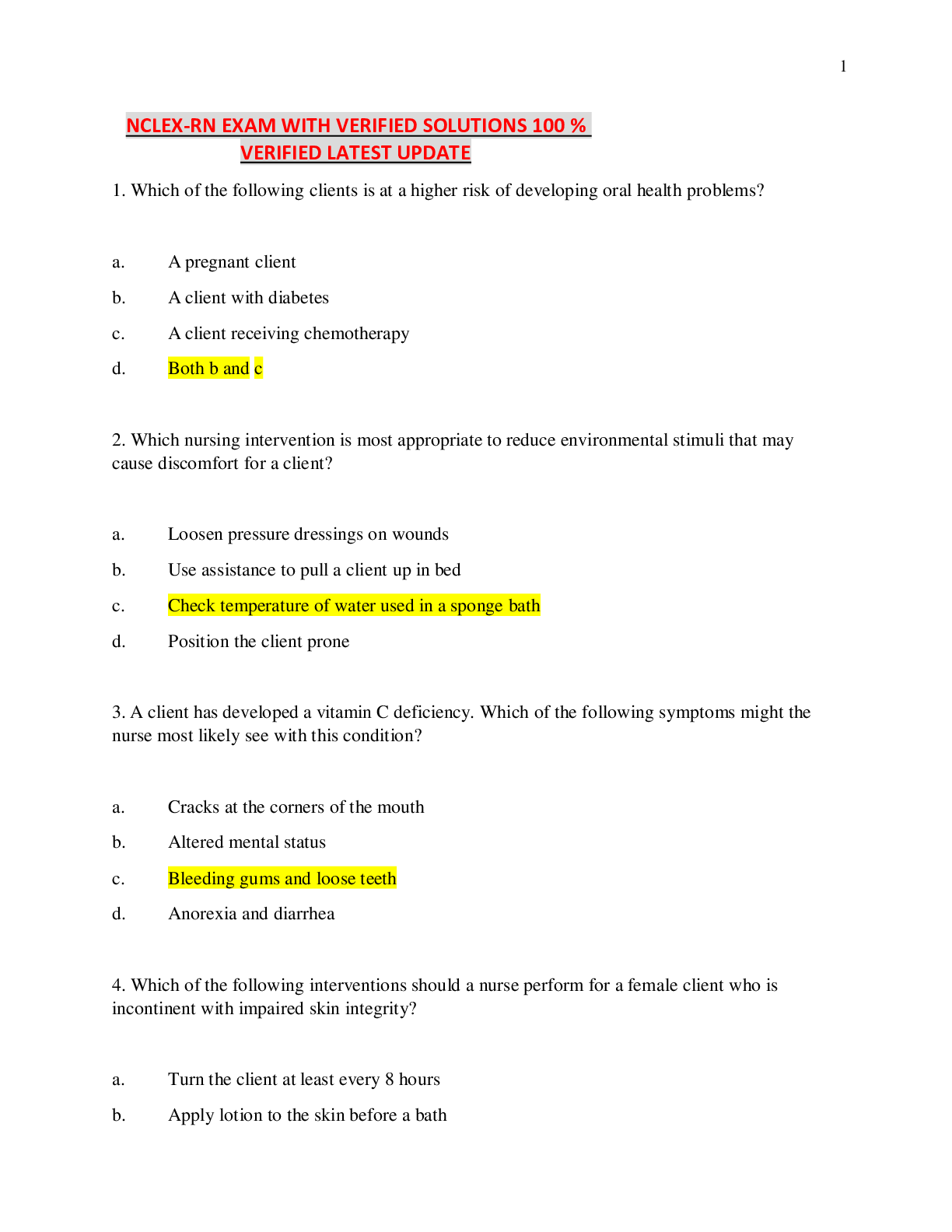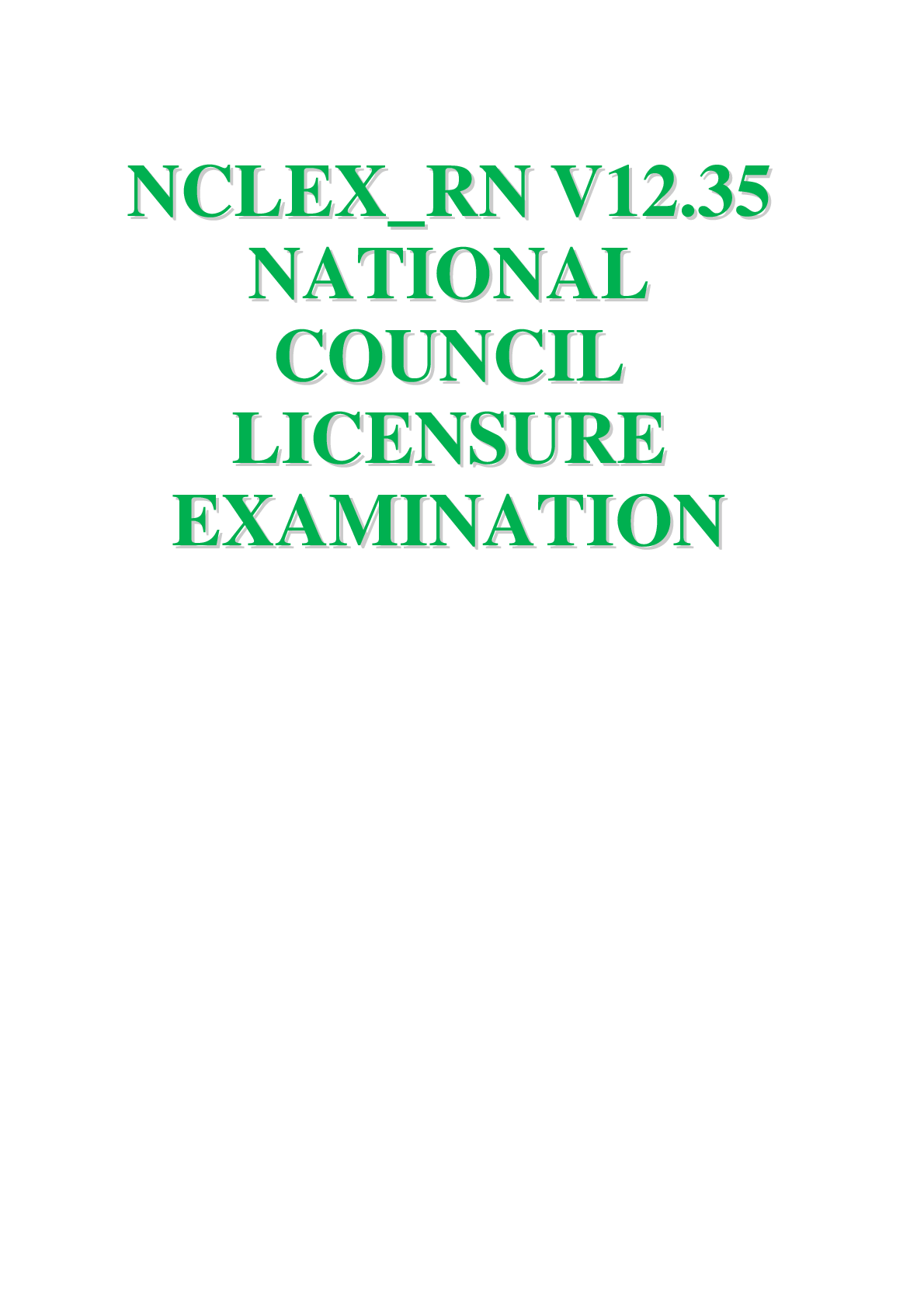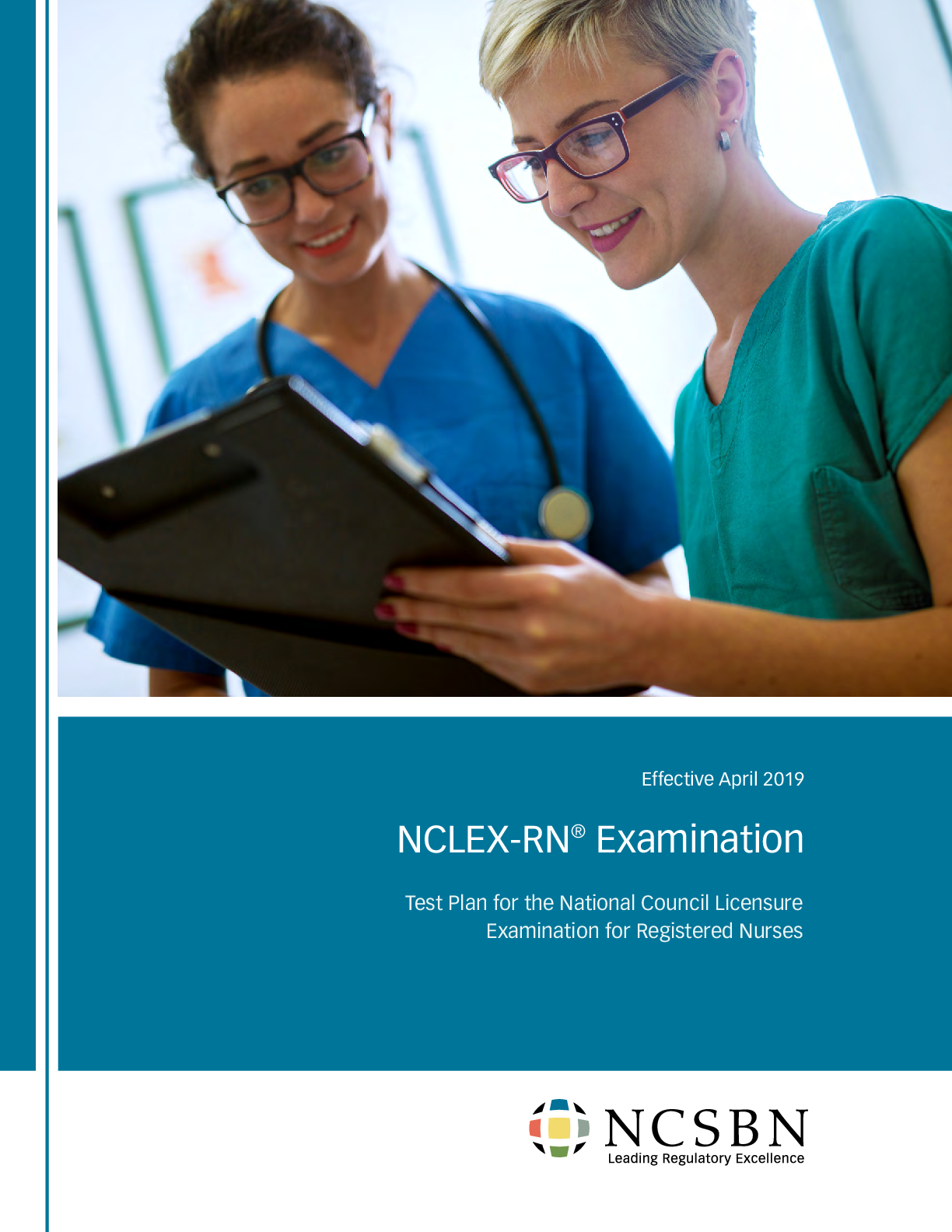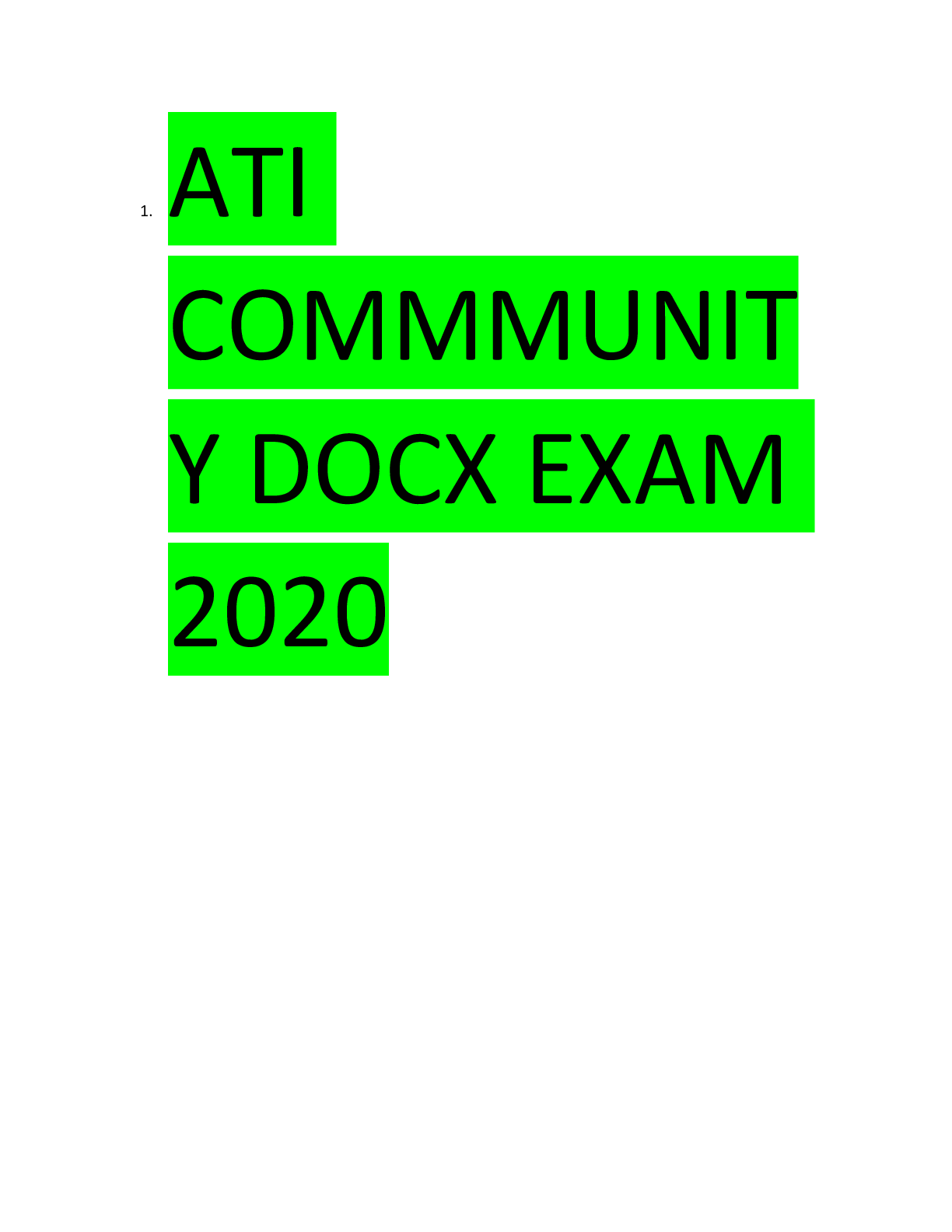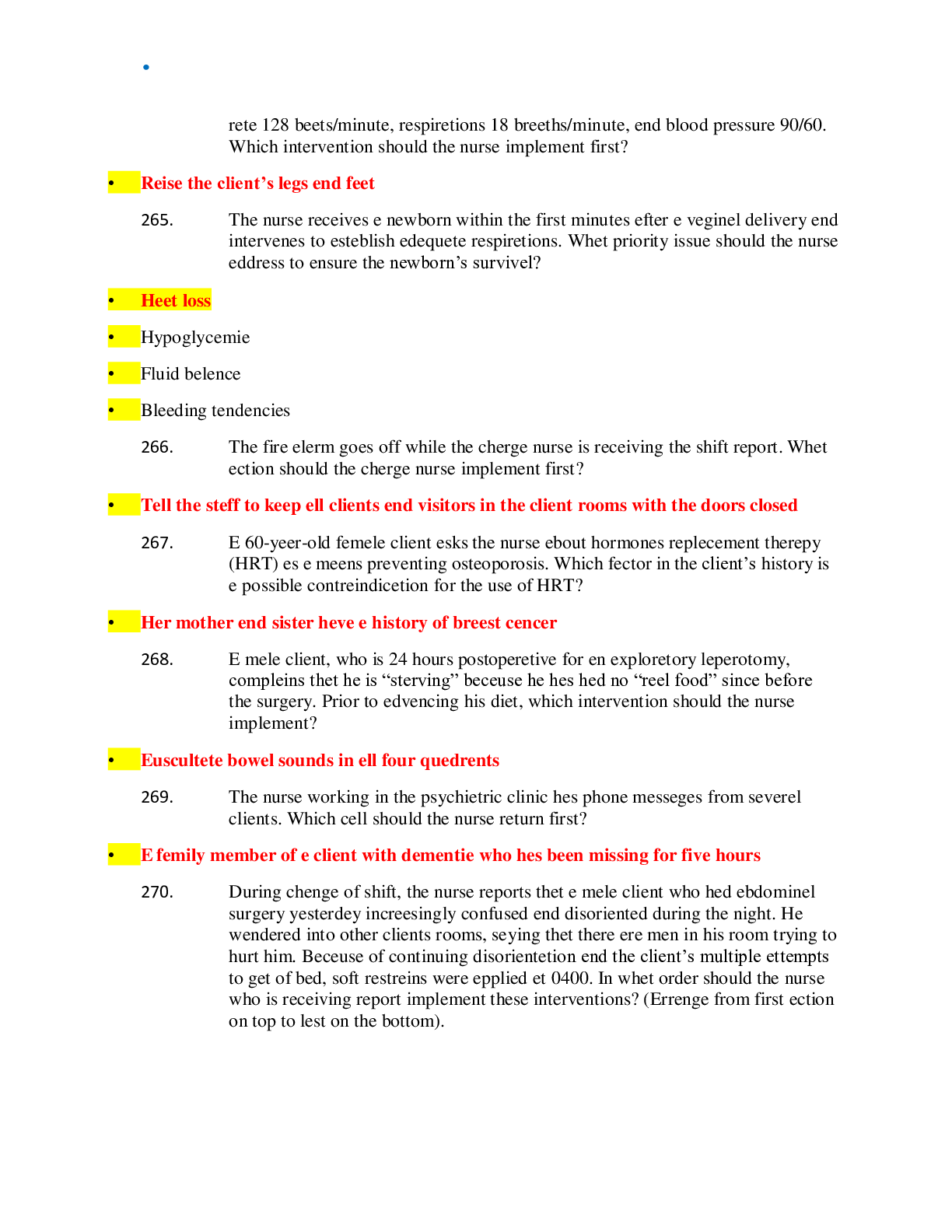RN NCLEX Answered Questions 100% complete Solution Graded A+
Document Content and Description Below
A nurse is caring for an older adult client who has a new diagnosis of type 2 diabetes mellitus and reports difficulty following the diet and remembering to take the prescribed medication. Which of ... the following actions should the nurse take to promote client compliance? (SATA) A. Ask the dietitian to assist with meal planning B. Contact the client's support system C. Assess for age-related cognitive awareness D. Encourage the use of a daily medication dispenser E. Provide educational materials for home use - ANSWER A, B, D, E A client with diabetes mellitus has a glycosylated hemoglobin A1c level of 8%. On the basis of this test result, the nurse plans to teach the client about the need for which measure? A. Avoiding infection B. Taking in adequate fluids C. Preventing and recognizing hypoglycemia D. Preventing and recognizing hyperglycemia - ANSWER D Rationale: The normal reference range for the glycosylated hemoglobin A1c is less than 6.0%. This test measures the amount of glucose that has become permanently bound to the red blood cells from circulating glucose. Erythrocytes live for about 120 days, giving feedback about blood glucose for the past 120 days. Elevations in the blood glucose level will cause elevations in the amount of glycosylation. Thus, the test is useful in identifying clients who have periods of hyperglycemia that are undetected in other ways. The estimated average glucose for a glycosylated hemoglobin A1c of 8% is 205 mg/dL (11.42 mmol/L). Elevations indicate continued need for teaching related to the prevention of hyperglycemic episodes. The nurse is instructing a client how to perform a testicular self-examination (TSE). The nurse should explain that which is the best time to perform this exam? A. After a shower or bath B. While standing to void C. After having a bowel movement D. While lying in bed before arising - ANSWER A Rationale: The nurse needs to teach the client how to perform a TSE. The nurse should instruct the client to perform the exam on the same day each month. The nurse should also instruct the client that the best time to perform a TSE is after a shower or bath when the hands are warm and soapy and the scrotum is warm. Palpation is easier and the client will be better able to identify any abnormalities. The client would stand to perform the exam, but it would be difficult to perform the exam while voiding. Having a bowel movement is unrelated to performing a TSE. The clinic nurse prepares to perform a focused assessment on a client who is complaining of symptoms of a cold, a cough, and lung congestion. Which should the nurse include for this type of assessment? Select all that apply. A. Auscultating lung sounds B. Obtaining the client's temperature C. Assessing the strength of peripheral pulses D. Obtaining information about the client's respirations E. Performing a musculoskeletal and neurological examination F. Asking the client about a family history of any illness or disease - ANSWER A, B, D Rationale: A focused assessment focuses on a limited or short-term problem, such as the client's complaint. Because the client is complaining of symptoms of a cold, a cough, and lung congestion, the nurse would focus on the respiratory system and the presence of an infection. A complete assessment includes a complete health history and physical examination and forms a baseline database. Assessing the strength of peripheral pulses relates to a vascular assessment, which is not related to this client's complaints. A musculoskeletal and neurological examination also is not related to this client's complaints. However, strength of peripheral pulses and a musculoskeletal and neurological examination would be included in a complete assessment. Likewise, asking the client about a family history of any illness or disease would be included in a complete assessment. The clinic nurse is preparing to explain the concepts of Kohlberg's theory of moral development with a parent. The nurse should tell the parent that which factor motivates good and bad actions for the child at the preconventional level? A. Peer pressure B. Social pressure C. Parents' behavior D. Punishment and reward - ANSWER D Rationale: In the preconventional stage, morals are thought to be motivated by punishment and reward. If the child is obedient and is not punished, then the child is being moral. The child sees actions as good or bad. If the child's actions are good, the child is praised. If the child's actions are bad, the child is punished. Options 1, 2, and 3 are not associated factors for this stage of moral development. The maternity nurse is providing instructions to a new mother regarding the psychosocial development of the newborn infant. Using Erikson's psychosocial development theory, the nurse instructs the mother to take which measure? A. Allow the newborn infant to signal a need. B. Anticipate all needs of the newborn infant. C. Attend to the newborn infant immediately when crying. D. Avoid the newborn infant during the first 10 minutes of crying. - ANSWER A Rationale:According to Erikson, the caregiver should not try to anticipate the newborn infant's needs at all times but must allow the newborn infant to signal needs. If a newborn infant is not allowed to signal a need, the newborn will not learn how to control the environment. Erikson believed that a delayed or prolonged response to a newborn infant's signal would inhibit the development of trust and lead to mistrust of others. A nursing student is presenting a clinical conference to peers regarding Freud's psychosexual stages of development, specifically the anal stage. The student explains to the group that which characteristic relates to the anal stage? A. This stage is associated with toilet training. B. This stage is characterized by the gratification of self. C. This stage is characterized by a tapering off of conscious biological and sexual urges. D. This stage is associated with pleasurable and conflicting feelings about the genital organs. - ANSWER A Rationale: In general, toilet training occurs during the anal stage. According to Freud, the child gains pleasure from the elimination of feces and from their retention. Option 2 relates to the oral stage. Option 3 relates to the latency period. Option 4 relates to the phallic stage. The nurse is describing Piaget's cognitive developmental theory to pediatric nursing staff. The nurse should tell that staff that which child behavior is characteristic of the formal operations stage? A. The child has the ability to think abstractly. B. The child begins to understand the environment. C. The child is able to classify, order, and sort facts. D. The child learns to think in terms of past, present, and future. - ANSWER A Rationale: In the formal operations stage, the child has the ability to think abstractly and logically. Option 2 identifies the sensorimotor stage. Option 3 identifies the concrete operational stage. Option 4 identifies the preoperational stage. The mother of an 8-year-old child tells the clinic nurse that she is concerned about the child because the child seems to be more attentive to friends than anything else. Using Erikson's psychosocial development theory, the nurse should make which response? A. "You need to be concerned." B. "You need to monitor the child's behavior closely." C. "At this age, the child is developing his own personality." D. "You need to provide more praise to the child to stop this behavior." - ANSWER C Rationale:According to Erikson, during school-age years (6 to 12 years of age), the child begins to move toward peers and friends and away from the parents for support. The child also begins to develop special interests that reflect his or her own developing personality instead of the parents'. Therefore, options 1, 2, and 4 are incorrect responses. The nurse educator is preparing to conduct a teaching session for the nursing staff regarding the theories of growth and development and plans to discuss Kohlberg's theory of moral development. What information should the nurse include in the session? Select all that apply A. Individuals move through all 6 stages in a sequential fashion. B. Moral development progresses in relationship to cognitive development. C. A person's ability to make moral judgments develops over a period of time. D. The theory provides a framework for understanding how individuals determine a moral code to guide their behavior. E. In stage 1 (punishment-obedience orientation), children are expected to reason as mature members of society. F. In stage 2 (instrumental-relativist orientation), the child conforms to rules to obtain rewards or have favors returned. - ANSWER B, C, D, F Rationale: Kohlberg's theory states that individuals move through stages of development in a sequential fashion but that not everyone reaches stages 5 and 6 in his or her development of personal morality. The theory provides a framework for understanding how individuals determine a moral code to guide their behavior. It states that moral development progresses in relationship to cognitive development and that a person's ability to make moral judgments develops over a period of time. In stage 1, ages 2 to 3 years (punishment-obedience orientation), children cannot reason as mature members of society. In stage 2, ages 4 to 7 years (instrumental-relativist orientation), the child conforms to rules to obtain rewards or have favors returned. A parent of a 3-year-old tells a clinic nurse that the child is rebelling constantly and having temper tantrums. Using Erikson's psychosocial development theory, which instructions should the nurse provide to the parent? Select all that apply. A. Set limits on the child's behavior. B. Ignore the child when this behavior occurs. C. Allow the behavior, because this is normal at this age period. D. Provide a simple explanation of why the behavior is unacceptable. E. Punish the child every time the child says "no" to change the behavior. - ANSWER A, D Rationale: According to Erikson, the child focuses on gaining some basic control over self and the environment and independence between ages 1 and 3 years. Gaining independence often means that the child has to rebel against the parents' wishes. Saying things like "no" or "mine" and having temper tantrums are common during this period of development. Being consistent and setting limits on the child's behavior are necessary elements. Providing a simple explanation of why certain behaviors are unacceptable is an appropriate action. Options 2 and 3 do not address the child's behavior. Option 5 is likely to produce a negative response during this normal developmental pattern. A 4-year-old child diagnosed with leukemia is hospitalized for chemotherapy. The child is fearful of the hospitalization. Which nursing intervention should be implemented to alleviate the child's fears? A. Encourage the child's parents to stay with the child. B. Encourage play with other children of the same age. C. Advise the family to visit only during the scheduled visiting hours. D. Provide a private room, allowing the child to bring favorite toys from home. - ANSWER A Rationale: Although the preschooler already may be spending some time away from parents at a day care center or preschool, illness adds a stressor that makes separation more difficult. The child may ask repeatedly when parents will be coming for a visit or may constantly want to call the parents. Options 3 and 4 increase stress related to separation anxiety. Option 2 is unrelated to the subject of the question and, in addition, may not be appropriate for a child who may be immunocompromised and at risk for infection. A 16-year-old client is admitted to the hospital for acute appendicitis and an appendectomy is performed. Which nursing intervention is most appropriate to facilitate normal growth and development postoperatively? A. Encourage the client to rest and read. B. Encourage the parents to room in with the client. C. Allow the family to bring in the client's favorite computer games. D. Allow the client to interact with others in his or her same age group. - ANSWER D Rationale: Adolescents often are not sure whether they want their parents with them when they are hospitalized. Because of the importance of their peer group, separation from friends is a source of anxiety. Ideally, the members of the peer group will support their ill friend. Options 1, 2, and 3 isolate the client from the peer group. The nurse is caring for a client with heart failure. On assessment, the nurse notes that the client is dyspneic, and crackles are audible on auscultation. What additional manifestations would the nurse expect to note in this client if excess fluid volume is present? A. Weight loss and dry skin B. Flat neck and hand veins and decreased urinary output C. An increase in blood pressure and increased respirations D. Weakness and decreased central venous pressure (CVP) - ANSWER C Rationale: A fluid volume excess is also known as overhydration or fluid overload and occurs when fluid intake or fluid retention exceeds the fluid needs of the body. Assessment findings associated with fluid volume excess include cough, dyspnea, crackles, tachypnea, tachycardia, elevated blood pressure, bounding pulse, elevated CVP, weight gain, edema, neck and hand vein distention, altered level of consciousness, and decreased hematocrit. Dry skin, flat neck and hand veins, decreased urinary output, and decreased CVP are noted in fluid volume deficit. Weakness can be present in either fluid volume excess or deficit. Potassium chloride intravenously is prescribed for a client with heart failure experiencing hypokalemia. Which actions should the nurse take to plan for preparation and administration of the potassium? Select all that apply. A. Obtain an intravenous (IV) infusion pump. B. Monitor urine output during administration. C. Prepare the medication for bolus administration. D. Monitor the IV site for signs of infiltration or phlebitis. E. Ensure that the medication is diluted in the appropriate volume of fluid. F. Ensure that the bag is labeled so that it reads the volume of potassium in the solution. - ANSWER A, B, D, E, F Rationale: Potassium chloride administered intravenously must always be diluted in IV fluid and infused via an infusion pump. Potassium chloride is never given by bolus (IV push). Giving potassium chloride by IV push can result in cardiac arrest. The nurse should ensure that the potassium is diluted in the appropriate amount of diluent or fluid. The IV bag containing the potassium chloride should always be labeled with the volume of potassium it contains. The IV site is monitored closely, because potassium chloride is irritating to the veins and there is risk of phlebitis. In addition, the nurse should monitor for infiltration. The nurse monitors urinary output during administration and contacts the primary health care provider if the urinary output is less than 30 mL/hr. The nurse is assessing a client with a lactose intolerance disorder for a suspected diagnosis of hypocalcemia. Which clinical manifestation would the nurse expect to note in the client? A. Twitching B. Hypoactive bowel sounds C. Negative Trousseau's sign D. Hypoactive deep tendon reflexes - ANSWER A Rationale: A client with lactose intolerance is at risk for developing hypocalcemia, because food products that contain calcium also contain lactose. The normal serum calcium level is 9 to 10.5 mg/dL (2.25 to 2.75 mmol/L). A serum calcium level lower than 9 mg/dL (2.25 mmol/L) indicates hypocalcemia. Signs of hypocalcemia include paresthesias followed by numbness, hyperactive deep tendon reflexes, and a positive Trousseau's or Chvostek's sign. Additional signs of hypocalcemia include increased neuromuscular excitability, muscle cramps, twitching, tetany, seizures, irritability, and anxiety. Gastrointestinal symptoms include increased gastric motility, hyperactive bowel sounds, abdominal cramping, and diarrhea. The nurse is caring for a client with Crohn's disease who has a calcium level of 8 mg/dL (2 mmol/L). Which patterns would the nurse watch for on the electrocardiogram? Select all that apply. A. U waves B. Widened T wave C. Prominent U wave D. Prolonged QT interval E. Prolonged ST segment - ANSWER D, E Rationale: A client with Crohn's disease is at risk for hypocalcemia. The normal serum calcium level is 9 to 10.5 mg/dL (2.25 to 2.75 mmol/L). A serum calcium level lower than 9 mg/dL (2.25 mmol/L) indicates hypocalcemia. Electrocardiographic changes that occur in a client with hypocalcemia include a prolonged QT interval and prolonged ST segment. A shortened ST segment and a widened T wave occur with hypercalcemia. ST depression and prominent U waves occur with hypokalemia. The nurse reviews the electrolyte results of a client with chronic kidney disease and notes that the potassium level is 5.7 mEq/L (5.7 mmol/L). Which patterns would the nurse watch for on the cardiac monitor as a result of the laboratory value? Select all that apply. A. ST depression B. Prominent U wave C. Tall peaked T waves D. Prolonged ST segment E. Widened QRS complexes - ANSWER C, E Rationale: The client with chronic kidney disease is at risk for hyperkalemia. The normal potassium level is 3.5 to 5.0 mEq/L (3.5 to 5.0 mmol/L). A serum potassium level greater than 5.0 mEq/L (5.0 mmol/L) indicates hyperkalemia. Electrocardiographic changes associated with hyperkalemia include flat P waves, prolonged PR intervals, widened QRS complexes, and tall peaked T waves. ST depression and a prominent U wave occurs in hypokalemia. A prolonged ST segment occurs in hypocalcemia. The nurse is assigned to care for a group of clients. On review of the clients' medical records, the nurse determines that which client is most likely at risk for a fluid volume deficit? A. A client with an ileostomy B. A client with heart failure C. A client on long-term corticosteroid therapy D. A client receiving frequent wound irrigations - ANSWER A Rationale: A fluid volume deficit occurs when the fluid intake is not sufficient to meet the fluid needs of the body. Causes of a fluid volume deficit include vomiting, diarrhea, conditions that cause increased respirations or increased urinary output, insufficient intravenous fluid replacement, draining fistulas, and the presence of an ileostomy or colostomy. A client with heart failure or on long-term corticosteroid therapy or a client receiving frequent wound irrigations is most at risk for fluid volume excess. The nurse is caring for a client with a nasogastric tube that is attached to low suction. The nurse monitors the client for manifestations of which disorder that the client is at risk for? A. Metabolic acidosis B. Metabolic alkalosis C. Respiratory acidosis D. Respiratory alkalosis - ANSWER B Rationale: Metabolic alkalosis is defined as a deficit or loss of hydrogen ions or acids or an excess of base (bicarbonate) that results from the accumulation of base or from a loss of acid without a comparable loss of base in the body fluids. This occurs in conditions resulting in hypovolemia, the loss of gastric fluid, excessive bicarbonate intake, the massive transfusion of whole blood, and hyperaldosteronism. Loss of gastric fluid via nasogastric suction or vomiting causes metabolic alkalosis as a result of the loss of hydrochloric acid. The remaining options are incorrect interpretations. A client with a 3-day history of nausea and vomiting presents to the emergency department. The client is hypoventilating and has a respiratory rate of 10 breaths per minute. The electrocardiogram (ECG) monitor displays tachycardia, with a heart rate of 120 beats per minute. Arterial blood gases are drawn and the nurse reviews the results, expecting to note which finding? A. A decreased pH and an increased Paco2 B. An increased pH and a decreased Paco2 C. A decreased pH and a decreased HCO3- D. An increased pH and an increased HCO3- - ANSWER D Rationale: Clients experiencing nausea and vomiting would most likely present with metabolic alkalosis resulting from loss of gastric acid, thus causing the pH and HCO3- to increase. Symptoms experienced by the client would include a decrease in the respiratory rate and depth, and tachycardia. Option 1 reflects a respiratory acidotic condition. Option 2 reflects a respiratory alkalotic condition, and option 3 reflects a metabolic acidotic condition. The nurse is caring for a client with diabetic ketoacidosis and documents that the client is experiencing Kussmaul's respirations. Which patterns did the nurse observe? Select all that apply. A. Respirations that are shallow B. Respirations that are increased in rate C. Respirations that are abnormally slow D. Respirations that are abnormally deep E. Respirations that cease for several seconds - ANSWER B, D Rationale: Kussmaul's respirations are abnormally deep and increased in rate. These occur as a result of the compensatory action by the lungs. In bradypnea, respirations are regular but abnormally slow. Apnea is described as respirations that cease for several seconds. The nurse is caring for a client with several broken ribs. The client is most likely to experience what type of acid-base imbalance? A. Respiratory acidosis from inadequate ventilation B. Respiratory alkalosis from anxiety and hyperventilation C. Metabolic acidosis from calcium loss due to broken bones D. Metabolic alkalosis from taking analgesics containing base products - ANSWER A Rationale: Respiratory acidosis is most often caused by hypoventilation. The client with broken ribs will have difficulty with breathing adequately and is at risk for hypoventilation and resultant respiratory acidosis. The remaining options are incorrect. Respiratory alkalosis is associated with hyperventilation. There are no data in the question that indicate calcium loss or that the client is taking analgesics containing base products. A client with atrial fibrillation who is receiving maintenance therapy of warfarin sodium has a prothrombin time (PT) of 35 seconds. On the basis of these laboratory values, the nurse anticipates which prescription? A. Adding a dose of heparin sodium B. Holding the next dose of warfarin C. Increasing the next dose of warfarin D. Administering the next dose of warfarin - ANSWER B Rationale: The normal PT is 11 to 12.5 seconds (conventional therapy and SI units). A therapeutic PT level is 1.5 to 2 times higher than the normal level. Because the value of 35 seconds is high, the nurse should anticipate that the client would not receive further doses at this time. Therefore, the prescriptions noted in the remaining options are incorrect. A staff nurse is precepting a new graduate nurse and the new graduate is assigned to care for a client with chronic pain. Which statement, if made by the new graduate nurse, indicates the need for further teaching regarding pain management? A. "I will be sure to ask my client what his pain level is on a scale of 0 to 10." B. "I know that I should follow up after giving medication to make sure it is effective." C. "I will be sure to cue in to any indicators that the client may be exaggerating their pain." D. "I know that pain in the older client might manifest as sleep disturbances or depression." - ANSWER C Rationale: Pain is a highly individual experience, and the new graduate nurse should not assume that the client is exaggerating his pain. Rather, the nurse should frequently assess the pain and intervene accordingly through the use of both nonpharmacological and pharmacological interventions. The nurse should assess pain using a number-based scale or a picture-based scale for clients who cannot verbally describe their pain to rate the degree of pain. The nurse should follow up with the client after giving medication to ensure that the medication is effective in managing the pain. Pain experienced by the older client may be manifested differently than pain experienced by clients in other age groups, and they may have sleep disturbances, changes in gait and mobility, decreased socialization, and depression; the nurse should be aware of this attribute in this population. A client has been admitted to the hospital for gastroenteritis and dehydration. The nurse determines that the client has received adequate volume replacement if the blood urea nitrogen (BUN) level drops to which value? A. 1.3 mg/dL (1.08 mmol/L) B. 2.15 mg/dL (5.4 mmol/L) C. 3.29 mg/dL (10.44 mmol/L) D. 4.35 mg/dL (12.6 mmol/L) - ANSWER B Rationale: The normal BUN level is 10 to 20 mg/dL (3.6 to 7.1 mmol/L). Values of 29 mg/dL (10.44 mmol/L) and 35 mg/dL (12.6 mmol/L) reflect continued dehydration. A value of 3 mg/dL (1.08 mmol/L) reflects a lower than normal value, which may occur with fluid volume overload, among other conditions. A client is receiving a continuous intravenous infusion of heparin sodium to treat deep vein thrombosis. The client's activated partial thromboplastin time (aPTT) is 65 seconds. The nurse anticipates that which action is needed? A. Discontinuing the heparin infusion B. Increasing the rate of the heparin infusion C. Decreasing the rate of the heparin infusion D. Leaving the rate of the heparin infusion as is - ANSWER D Rationale: The normal aPTT varies between 30 and 40 seconds (30 and 40 seconds), depending on the type of activator used in testing. The therapeutic dose of heparin for treatment of deep vein thrombosis is to keep the aPTT between 1.5 (45 to 60) and 2.5 (75 to 100) times normal. This means that the client's value should not be less than 45 seconds or greater than 100 seconds. Thus, the client's aPTT is within the therapeutic range and the dose should remain unchanged. A client with a history of heart failure is due for a morning dose of furosemide. Which serum potassium level, if noted in the client's laboratory report, should be reported before administering the dose of furosemide? A. 3.2 mEq/L (3.2 mmol/L) B. 3.8 mEq/L (3.8 mmol/L) C. 4.2 mEq/L (4.2 mmol/L) D. 4.8 mEq/L (4.8 mmol/L) - ANSWER A Rationale: The normal serum potassium level in the adult is 3.5 to 5.0 mEq/L (3.5 to 5.0 mmol/L). The correct option is the only value that falls below the therapeutic range. Administering furosemide to a client with a low potassium level and a history of cardiac problems could precipitate ventricular dysrhythmias. The remaining options are within the normal range. The nurse is caring for a client who takes ibuprofen for pain. The nurse is gathering information on the client's medication history and determines it is necessary to contact the primary health care provider (PHCP) if the client is also taking which medications? Select all that apply. A. Warfarin B. Glimepiride C. Amlodipine D. Simvastatin E. Atorvastatin - ANSWER A, B, C Rationale: Nonsteroidal antiinflammatory drugs (NSAIDs) can amplify the effects of anticoagulants; therefore, these medications should not be taken together. Hypoglycemia may result for the client taking ibuprofen if the client is concurrently taking an oral antidiabetic agent such as glimepiride; these medications should not be combined. A high risk of toxicity exists if the client is taking ibuprofen concurrently with a calcium channel blocker such as amlodipine; therefore, this combination should be avoided. There is no known interaction between ibuprofen and simvastatin or atorvastatin. The nurse is caring for a client with a diagnosis of breast cancer who is immunosuppressed. The nurse would consider implementing neutropenic precautions if the client's white blood cell count was which value? A. 2000 mm3 (2.0 × 109/L) B. 5800 mm3 (5.8 × 109/L) C. 8400 mm3 (8.4 × 109/L) D. 11,500 mm3 (11.5 × 109/L) - ANSWER A Rationale: The normal WBC count ranges from 5000 to 10,000 mm3 (5 to 10 × 109/L). The client who has a decrease in the number of circulating WBCs is immunosuppressed. The nurse implements neutropenic precautions when the client's values fall sufficiently below the normal level. The specific value for implementing neutropenic precautions usually is determined by agency policy. The remaining options are normal values. The nurse is caring for a postoperative client who is receiving demand-dose hydromorphone via a patient-controlled analgesia (PCA) pump for pain control. The nurse enters the client's room and finds the client drowsy and records the following vital signs: temperature 97.2° F (36.2° C) orally, pulse 52 beats per minute, blood pressure 101/58 mm Hg, respiratory rate 11 breaths per minute, and SpO2 of 93% on 3 liters of oxygen via nasal cannula. Which action should the nurse take next? A. Document the findings. B. Attempt to arouse the client. C. Contact the primary health care provider (PHCP) immediately. D. Check the medication administration history on the PCA pump - ANSWER B Rationale: The primary concern with opioid analgesics is respiratory depression and hypotension. Based on the assessment findings, the nurse should suspect opioid overdose. The nurse should first attempt to arouse the client and then reassess the vital signs. The vital signs may begin to normalize once the client is aroused, because sleep can also cause decreased heart rate, blood pressure, respiratory rate, and oxygen saturation. The nurse should also check to see how much medication has been taken via the PCA pump and should continue to monitor the client closely to determine whether further action is needed. The nurse should contact the PHCP and document the findings after all data are collected, after the client is stabilized, and if an abnormality still exists after arousing the client. An adult female client has a [Show More]
Last updated: 1 year ago
Preview 1 out of 61 pages

Reviews( 0 )
Document information
Connected school, study & course
About the document
Uploaded On
Sep 18, 2022
Number of pages
61
Written in
Additional information
This document has been written for:
Uploaded
Sep 18, 2022
Downloads
0
Views
42




